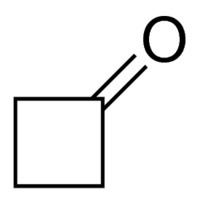Formula C4H6O Appearance Colorless liquid | Density 954.7 kg/m³ | |
 | ||
What does cyclobutanone mean
Cyclobutanone is an organic compound with molecular formula C4H6O. It is a four-membered cyclic ketone (cycloalkanone). Unlike cyclopropanone, the smallest but extremely volatile cyclic ketone, cyclobutanone is a stable liquid at room temperature and can be distilled.
Contents
Preparation
The Russian chemist Nikolai Kischner first reported the preparation of cyclobutanone in 1905. He synthesized cyclobutanone in a low yield from cyclobutanecarboxylic acid in several reaction steps. This process is cumbersome and inefficient by today's standards.
More efficient, high-yielding syntheses have since been developed. One strategy involves degradation of five-carbon building blocks. For example, the oxidative decarboxylation of cyclobutanecarboxylic acid was improved by the use of other reagents and methods. A newer, more efficient preparation of cyclobutanone was found by P. Lipp and R. Köster in which a solution of diazomethane in diethyl ether is reacted with ketene. This reaction is based on a ring expansion of the cyclopropanone intermediate initially formed, wherein molecular nitrogen is split off. The reaction mechanism was confirmed by a reaction using 14C-labeled diazomethane.
Another method for the synthesis of cyclobutanone is through a lithium-catalyzed rearrangement of oxaspiropentane, which is formed by epoxidation of the easily accessible methylenecyclopropane.
Cyclobutanone can also be prepared in a two step procedure by dialkylation of 1,3-dithiane with 1-bromo-3-chloropropane followed by deprotection to the ketone with mercuric chloride (HgCl2) and cadmium carbonate (CdCO3).
Reactions
At about 350 °C, cyclobutanone decomposes into ethylene and ketene. The activation energy for this [2+2] cycloreversion is 52 kcal/mol. The reversion reaction, the [2+2] cycloaddition of ketene and ethylene, has never been observed.
